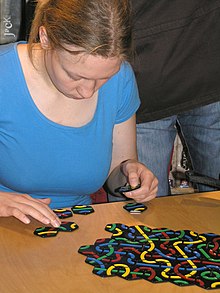Tantrix
Tantrix is a strategy and placement game for 1 to 4 people designed by the New Zealand mathematician Mike McManaway in 1987 and is played with 56 hexagonal synthetic resin tiles.
The plates are printed with three connecting lines that connect two sides and always have three of the four colors red, yellow, green and blue. Since at most one straight connecting line connects opposite sides, there are exactly 56 different pieces.
Rules of the game
A common rule applies to most game variants: two stones may only border one another with the same line color. This often creates ever longer lines of different colors, which represent the main focus of the game.
In addition, the following laying rules apply to many variants:
- The structure resulting from the laid out platelets must not contain any holes.
- A maximum of two lines of the same color may lead into a free space. It can also be surrounded by a maximum of three other stones, making it a forced space .
- In a strategy game, the following applies: forced spaces must be filled as long as the active player gets the right stones in his hand.
- A side on which there is already a forced space may only be laid out in such a way that no new forced space is created either directly or through forced moves .
Game variants
Basically, two game variants can be distinguished: puzzle and strategy game . The latter can be played with the Tantrix Game Pack , which consists of all 56 numbered pieces.
- In the so-called Discovery Puzzle , either the pieces with the numbers 1 to 30 from the game pack or the 10 pieces contained in a separately available Discovery Set are used. The player begins with stones one to three and lays a loop (closed line) consisting of all stones in the color of the stone with the highest number (here number 3 = yellow) on the back. For further levels of difficulty, the previous loop is dissolved and the stone with the next higher number is added, which now specifies the color to be used.
- In a strategy game, 2 to 4 players try to lay a line as long as possible or a closed curve as long as possible in their chosen color on a shared playing field. An increasing number of players shifts the focus from tactical planning to playful skill.
In addition to the discovery puzzle, there are a number of other puzzle variants for one or more players that are more or less well documented. The playing time ranges from a few minutes for simpler puzzles to about 30 minutes for a strategy game to hours or days of occupation with particularly difficult puzzles.
rating
Tantrix is a game to train spatial awareness and concentration.
Web links
- Tantrix in the Luding games database
- Tantrix.com - official website on which the strategy variant with or without application against other players or different degrees of bots can be played
- Tantrix in Germany - German branch at quecke-Verlag
- Tantrix Software - Tantrix as Windows software, for free download
- Tantrix Game - official Tantrix online game
Individual evidence
- ↑ From the FAQ on tantrix.com : The negative consequences of this caused the removal of the triple intersection tiles from the game in 1993.


